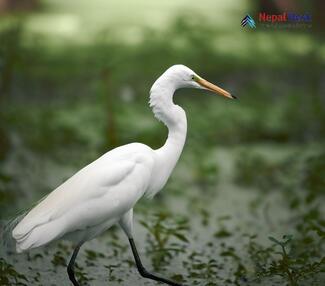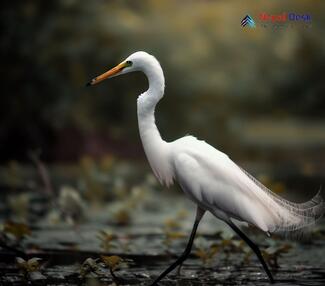Nepal, a country known for its diverse wildlife and breathtaking landscapes, is a haven for bird lovers. Among the multitude of avian species found here, the Intermediate Egret holds a particular charm. This elusive wading bird can be spotted gracefully wandering through the wetlands and water bodies within Nepal's lush ecosystems. In this article, we'll delve into the details of the captivating Intermediate Egret and explore its presence in Nepal.
Characteristics of the Intermediate Egret
The Intermediate Egret, scientifically known as Ardea intermedia, belongs to the Ardeidae family of herons, egrets, and bitterns. As its name suggests, this egret is medium-sized compared to its relatives – standing taller than the Little Egret and slightly shorter than the Great Egret. The Intermediate Egret measures approximately 56-72cm in length and weighs around 400-800g.
These birds showcase an elegant all-white plumage that complements their black legs and yellow feet. Their long, sharp bills are ideally suited to help them catch their prey—consisting mainly of fish, amphibians, insects, crustaceans, and small mammals. When breeding season arrives, the normally-yellow bill turns black to signify that it is ready for mating.
Habitat and Distribution: Where to Find Intermediate Egrets
The Intermediate Egret predominantly resides in freshwater habitats such as rivers, lakes, ponds, swamps, marshes, and even paddy fields. They are solitary feeders with a stealthy hunting approach to snag prey from shallow water edges.
As for their presence specifically in Nepal, sightings have been reported across several regions including Chitwan National Park—particularly around the Rapti River area—as well as Koshi Tappu Wildlife Reserve located in eastern Terai. Bird enthusiasts visiting these areas during various seasons have successfully observed and photographed the Intermediate Egret in action.
Importance of Conservation Efforts
Unfortunately, Nepal's wetlands and natural habitats are under continuous threat due to habitat degradation, pollution, and the spread of invasive species. As these areas provide crucial breeding grounds and food sources for Intermediate Egrets and many other bird species, conservation efforts are essential for maintaining populations.
Organizations such as Bird Conservation Nepal work diligently with local communities, promoting habitat preservation, sustainable ecotourism, and educational programs. By taking steps to conserve these vital ecosystems, we can ensure their beauty – as well as fantastic birdlife like the Intermediate Egret – will persist for generations to come.
In Summary
Bird enthusiasts seeking to witness the elegance of the Intermediate Egret can find solace in Nepal's rich avian diversity. With ecological importance and unassuming beauty, this egret will undoubtedly continue to charm those fortunate enough to encounter it. By familiarizing ourselves with its characteristics and spreading awareness of its presence in the stunning wetlands of Nepal, we play our part in ensuring its continued survival within this unique region.




